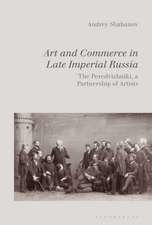Is Paris Still the Capital of the Nineteenth Century?: Essays on Art and Modernity, 1850-1900
Editat de Hollis Clayson, André Dombrowskien Limba Engleză Hardback – 16 iun 2016
| Toate formatele și edițiile | Preț | Express |
|---|---|---|
| Paperback (1) | 384.22 lei 43-57 zile | |
| Taylor & Francis – 14 mai 2019 | 384.22 lei 43-57 zile | |
| Hardback (1) | 1121.81 lei 43-57 zile | |
| Taylor & Francis – 16 iun 2016 | 1121.81 lei 43-57 zile |
Preț: 1121.81 lei
Preț vechi: 1368.06 lei
-18% Nou
Puncte Express: 1683
Preț estimativ în valută:
214.73€ • 233.32$ • 180.49£
214.73€ • 233.32$ • 180.49£
Carte tipărită la comandă
Livrare economică 21 aprilie-05 mai
Preluare comenzi: 021 569.72.76
Specificații
ISBN-13: 9781472460141
ISBN-10: 1472460146
Pagini: 324
Ilustrații: 67
Dimensiuni: 174 x 246 x 21 mm
Greutate: 0.82 kg
Ediția:1
Editura: Taylor & Francis
Colecția Routledge
Locul publicării:Oxford, United Kingdom
ISBN-10: 1472460146
Pagini: 324
Ilustrații: 67
Dimensiuni: 174 x 246 x 21 mm
Greutate: 0.82 kg
Ediția:1
Editura: Taylor & Francis
Colecția Routledge
Locul publicării:Oxford, United Kingdom
Cuprins
Contents
List of Figures
Notes on Contributors
Acknowledgements
Introduction
Hollis Clayson and André Dombrowski
SECTION I: MODERNITY
Introduction by André Dombrowski
1 Architecture’s Capital? Revisiting Benjamin’s Paris
Charles Rice
2 How Haussmann’s Hegemony Haunted the Early Third Republic
Peter Soppelsa
3 The Guillotine Sublime
Marc Gotlieb
4 Victorine’s Secret: Baudelaire and the Ambiguity of Commodities
Paul Smith
5 A Laughter of the Look: Manet, Mallarmé, Polichinelle, and the Salon Jury in 1874
Margaret Werth
SECTION II: GEOGRAPHY
Introduction by Hollis Clayson
6 Revisiting the 1860s: Race and Place in Cape Town and Paris
Tamar Garb
7 Osman Hamdi Bey and Ottoman Aestheticism
Mary Roberts
8 Paris, Japan, and Modernity: A Vexed Ratio
Ting Chang
9 White City vs. La Ville lumière: Electrical Displays at the World’s Columbian Exposition, Chicago (1893)
Hélène Valance
SECTION III: CIRCULATION
Introduction by Hollis Clayson
10 Manet and the Multiple
Anne Higonnet
11 Gesture, Pose, Practice: Charles Nègre and the Image of Instantaneity
Jacob W. Lewis
12 Living on Manet’s Balcony, or the Right to Privacy
André Dombrowski
13 Mary Cassatt’s Lamp
Hollis Clayson
Afterword
Hollis Clayson and André Dombrowski
Further Reading
Index
List of Figures
Notes on Contributors
Acknowledgements
Introduction
Hollis Clayson and André Dombrowski
SECTION I: MODERNITY
Introduction by André Dombrowski
1 Architecture’s Capital? Revisiting Benjamin’s Paris
Charles Rice
2 How Haussmann’s Hegemony Haunted the Early Third Republic
Peter Soppelsa
3 The Guillotine Sublime
Marc Gotlieb
4 Victorine’s Secret: Baudelaire and the Ambiguity of Commodities
Paul Smith
5 A Laughter of the Look: Manet, Mallarmé, Polichinelle, and the Salon Jury in 1874
Margaret Werth
SECTION II: GEOGRAPHY
Introduction by Hollis Clayson
6 Revisiting the 1860s: Race and Place in Cape Town and Paris
Tamar Garb
7 Osman Hamdi Bey and Ottoman Aestheticism
Mary Roberts
8 Paris, Japan, and Modernity: A Vexed Ratio
Ting Chang
9 White City vs. La Ville lumière: Electrical Displays at the World’s Columbian Exposition, Chicago (1893)
Hélène Valance
SECTION III: CIRCULATION
Introduction by Hollis Clayson
10 Manet and the Multiple
Anne Higonnet
11 Gesture, Pose, Practice: Charles Nègre and the Image of Instantaneity
Jacob W. Lewis
12 Living on Manet’s Balcony, or the Right to Privacy
André Dombrowski
13 Mary Cassatt’s Lamp
Hollis Clayson
Afterword
Hollis Clayson and André Dombrowski
Further Reading
Index
Notă biografică
Hollis Clayson is Bergen Evans Professor in the Humanities and Professor of Art History, Northwestern University, USA.
André Dombrowski is Associate Professor in History of Art, University of Pennsylvania, USA.
André Dombrowski is Associate Professor in History of Art, University of Pennsylvania, USA.
Recenzii
'There are times when divergent academic and ideological interests come together unexpectedly; these events can yield new scholarly insights even as they lay bare disciplinary antagonisms. A 2009 symposium at the Clark Art Institute was just such an occasion. Its interrogatory title Is Paris Still the Capital of the 19th Century? signaled the conveners’ interest in the legacies of Charles Baudelaire, Walter Benjamin, and T. J. Clark for the writing of nineteenth-century art history. Less clear was whether the title was meant ironically or in earnest. Were the conveners purposely begging the question? The publication of a related collection of essays now provides some answers. Edited by Hollis Clayson and André Dombrowski, who jointly organized the symposium, the volume includes essays by eight of the original speakers, augmented by contributions by five additional scholars.'
--CAA Reviews
'The essays in this volume draw us to a terrain we love and think we know, but by asking, "Is Paris still capital of the nineteenth century", the authors work to destabilize our knowledge of the capital of modernism and modernity. They accomplish this by probing the familiar to uncover new depths (Manet, Benjamin, Haussmannization); by juxtaposing painting with printmaking, photography, electric lighting; and by seeing Paris anew in a global context. Highly recommended.'
--Nancy Locke, The Pennsylvania State University, USA and author of Manet and the Family Romance
--CAA Reviews
'The essays in this volume draw us to a terrain we love and think we know, but by asking, "Is Paris still capital of the nineteenth century", the authors work to destabilize our knowledge of the capital of modernism and modernity. They accomplish this by probing the familiar to uncover new depths (Manet, Benjamin, Haussmannization); by juxtaposing painting with printmaking, photography, electric lighting; and by seeing Paris anew in a global context. Highly recommended.'
--Nancy Locke, The Pennsylvania State University, USA and author of Manet and the Family Romance
Descriere
"Is Paris Still the Capital of the Nineteenth Century?" The question that guides this volume stems from Walter Benjamin's studies of nineteenth-century Parisian culture as the apex of capitalist aesthetics. Thirteen scholars test Benjamin's ideas about the centrality of Paris, formulated in the 1930s, from a variety of methodological perspectives.






















